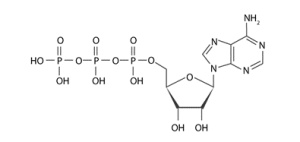Introduction
ATP is the source of energy for every cell in your body that keeps everything running. Adenosine triphosphate is the biological form of energy. Your body’s most abundant energy-carrying molecule is ATP. It utilises the chemical energy contained in food molecules to power the cell’s functions. ATP is the universal currency of your body’s cells. Your meal is divided down into individual macronutrient components. All of the carbs in your diet are broken down into simple sugars (glucose). That must first be transformed into ATP (the energy form that will work in the cell).Adenosine Triphosphate
- The cell’s energy currency is ATP (adenosine triphosphate)
- This chemical molecule is made up of phosphate groups, adenine (nitrogenous base) and sugar ribose. These molecules supply energy to the body’s metabolic operations. As a result, it’s known as the “Energy Currency of the Cell.” Mitochondria produces ATP molecules, which is why it is known as the cell’s powerhouse
- The connection between the second and third phosphate groups has a lot of energy that can be used to power chemical reactions
- When a cell needs energy, it uses the process of hydrolysis, also known as dephosphorylation, to break this connection and produce adenosine diphosphate (ADP) and a free phosphate molecule
- ADP stands for adenosine diphosphate, while Pi stands for inorganic phosphate in the aforementioned reaction
- ADP can be converted to ATP in the other direction, needing the same amount of energy released during the process, namely 30.6 KJ
- Condensation or phosphorylation is the term for this process. This occurs because the ATP molecule is highly unstable and rapidly hydrolysed. The phosphate group in the ATP molecule has weaker bonds than the ADP molecule
Structure of ATP ![]()
Adenosine triphosphate (ATP) is a nucleotide made up primarily of the adenosine molecule and three phosphate groups. Due to the presence of two phosphoanhydride bonds linking the three phosphate groups, It is water-soluble and has a high energy content.
The true power source that the cell taps is the triphosphate tail of ATP. The available energy is held in the phosphate bonds, which must be broken or divided into molecules in order to be released. The addition of a water molecule causes this to happen (hydrolysis). When only the outer phosphate group of ATP is removed to generate energy, ATP – adenosine triphosphate – is changed to ADP – adenosine diphosphate, which is a nucleotide with only two phosphates.
Three key components make up the majority of ATP molecules:-
- Ribose sugar is a pentose sugar molecule
- Adenine, a nitrogen base, is bonded to the sugar molecule’s first carbon
- The three phosphate groups are connected in a chain to the pentose sugar’s fifth carbon. Starting with the group closest to the ribose sugar, the phosphoryl groups are referred to as alpha, beta, and gamma phosphates. The activity of ATP is dependent on these phosphates
The ATP molecules produce energy in a variety of ways
- The three phosphate groups in this ATP molecule are known as high-energy bonds because when they are broken, they release a large amount of energy. This molecule provides energy to a number of biological activities, without which life would not be possible
- It is used in biosynthetic activities, cell divisions, and other cellular processes by a variety of enzymes and structural proteins. This “energy currency of the cell” is created during cellular respiration using a digested simple molecule of food
- The energy produced by the ATP molecules is stored in their bonds, which are then utilised by the cells by breaking the bonds as needed
Purposes of ATP
- ATP is required for a variety of biological processes, including molecule transport across cell membranes
- ATP also provides energy for muscular contraction, blood circulation, locomotion, and a variety of other physiological actions
- Apart from energy production, ATP plays an important function in the cell’s survival by generating the thousands of different macromolecules it needs. The ATP molecule serves as a switch for controlling chemical reactions and sending messages
Production of ATP
The production of ATP occurs in all of the body’s cells. When glucose is digested in the intestines, the process begins. Cells then take it up and convert it to pyruvate. It then moves to the mitochondria of the cells. That’s where ATP is made in the end. Your body would be full of energy it couldn’t use if it didn’t have the road to ATP generation. Adenosine triphosphate (ATP) is the global energy carrier and monetary unit. It stores all of the energy required by each cell to complete its functions. Like a rechargeable battery, once ATP is made, it may be utilised repeatedly. Electron Transport Chain The movement of electrons through a set of stages allows for a progressive decrease in electron energy. This stage of oxidative phosphorylation is referred to as the electron transport chain.- The electron transport chain can be found within mitochondria, and the electron transport chain proteins travel across the inner mitochondrial membrane. The mitochondrial membrane contains special proteins that are activated by NADH. They are constantly creating ATP to keep the cell running
- The electron transport chain produces approximately 34 or 36 molecules of ATP (adenosine triphosphate) for every molecule of glucose consumed during aerobic respiration. This is by far the most beneficial aspect of respiration
- The electron transport chain is composed of a series of redox processes that transfer electrons from a source molecule to an acceptor molecule. The free energy (energy available to do work) of the reactants and products is the driving force behind these reactions. Any response that lowers a system’s totally free energy will occur
- ATP synthase is an enzyme that can be found in all living things. A transmembrane proton electrochemical gradient powers it. The succession of redox reactions has resulted in this. This gradient is created by the electron transport chain. Free energy is used to fuel the production of ATP
- For electron transport phosphorylation, the electrons transferred through the NADH generated by glycolysis and the FADH2 produced by the citric acid cycle are used. A total of 32 ATP molecules are created throughout this procedure
 Profile
Profile Settings
Settings Refer your friends
Refer your friends Sign out
Sign out







